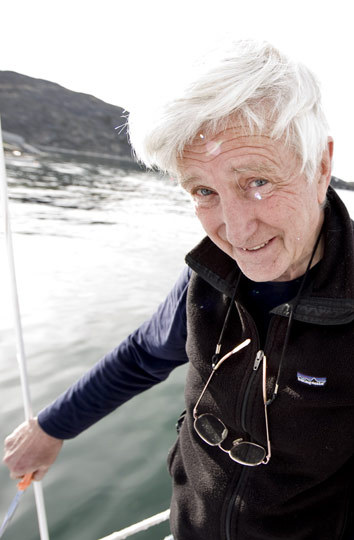
Bob Shepton [Photo] xpedition.be
Prior to the 1950s, climbing expeditions to remote peaks started with days, or weeks, spent at sea. When the French flew to Annapurna in 1950, the era of nautical travel practically ended. But some individuals still choose to combine open water and the climbing life.
In 2010, Scottish skipper/ex-priest Bob Shepton “lured” Belgians Nicolas Favresse, Olivier Favresse, Sean Villanueva and American Ben Ditto to the coast of Greenland with photos of a virgin wall, whose location he refused to disclose until they hired him to take them there. The climbers put up several new big-wall routes, using Shepton’s sailboat–Dodo’s Delight–as their floating base camp.
For details of their Piolet d’Or-winning adventure, read the following interview with Shepton and check out the September 14, 2010 NewsWire. –Ed.
What was the goal for your trip to Greenland with Sean Villanueva, Ben Ditto and the Favresse brothers?
Well it all started because I got this email from Nico asking if I knew any big walls to climb in Greenland. So rather unselfishly I said, “Yes, I do know where there are some big walls in Greenland, but I’m not going to tell you where they are because I want them for myself and my team.” But it so happens I had left the boat in Greenland after last summer’s expedition, so I agreed to take them there myself.
And the aim was simply that: climb some big walls in Greenland. Having been there several times I knew where there were some, and one in particular which I’d already named Impossible Wall because other groups had turned it down because they didn’t think they could do it.
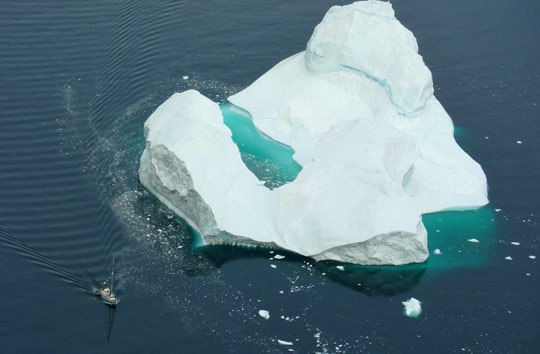
Shepton sails in to check on the climbers’ progress. [Photo] xpedition.be [Photo]
How long had you waited to take climbers to Greenland and the Impossible Wall?
About twelve years. I started going up there on these sailing/climbing expeditions in 1998, but we would have passed it then. For a good many years I had my eyes on that wall, but hadn’t had a team good enough to climb it.
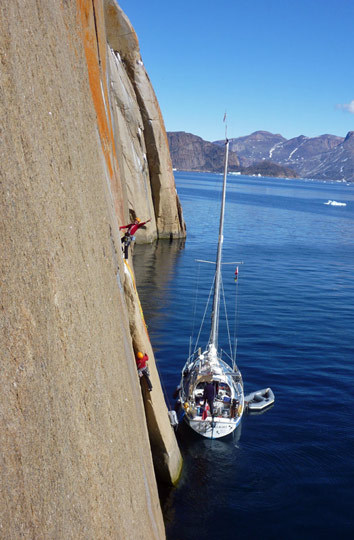
[Photo] xpedition.be
How did you get into climbing?
I was a Royal Marine in the early days–in the Commandos–and I did the cliff leaders’ course in the Commando Cliff Assault Wing. We’re talking way back in the 1950s here. I came to sailing quite late because I was such a fanatical rock climber for many years, combining it with the other things I was doing. I was fortunate enough to be posted down to Weymoth (this is when I had been ordained as a curator to the church there), and I found these unclimbed cliffs at Portland, on the south coast of England. I set about developing and climbing them with the church youth club and various friends.
So I’ve been climbing for many, many years, but not so much recently, especially when the sailing came about.
What is your most memorable climbing experience?
Wow. Well, I wouldn’t like to limit myself to one climb. I suppose the development of the Portland cliffs, which were entirely unclimbed at that time, was a major achievement. I did some fairly hard routes in north Wales on the big sea cliffs there also.

Bob Shepton [Photo] xpedition.be
What is the connection between climbing and sailing? Is there common ground?
All of these outdoor activities, as far as I’m concerned, have to do with challenge. I suppose that is the common denominator. It’s very nice when you can do both challenges in one expedition. But yes, it’s the challenge aspect that really attracts me. That is why I became quite an ambitious sailor early on.
You’re a retired priest. How does religion relate to climbing and/or sailing?
As I said to “the wild bunch”–Nico, Ollie, Ben and Sean–it’s a very prayerful experience climbing with them. They took me out on this climb in Greenland when I hadn’t been climbing seriously for some time. And that was a serious climb.
But I suppose there’s no immediate correlation except that you’re outdoors and in Creation and so forth.
Had you ever tried a trip like the one to Greenland in the past?
In 2000 we went up there with a British guide and two Italians. We made the first ascent of the north wall of San Jacinto. I looked at Impossible, but there was grass in the cracks and the team didn’t really fancy it.
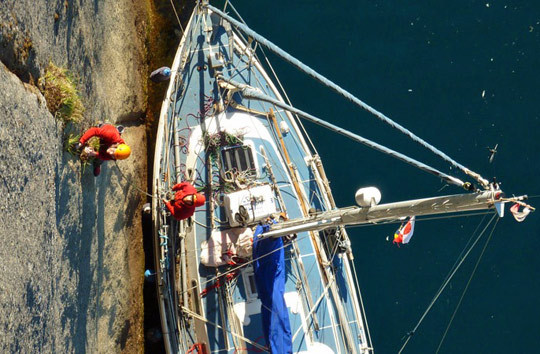
Ben Ditto starts up a big wall on the coast of Greenland. “Go climb that wall! And don’t come back unless you do!” Shepton shouted as they stepped off the boat and onto rock. [Photo] xpedition.be [Photo]
Were there any logistical issues with so much gear on a boat with limited space?
One does wonder how to get all this gear on the boat, and it’s amazing that it all stows away. Of course we were using one of the bunks in the forepeak just for gear. We could do that because there was five of us and six bunks.
How well did everyone get along?
Yes, well, that was the amazing thing about this expedition. We had corresponded but never met until they actually flew out to the boat in Greenland. That was the first time we’d ever met. They were wondering what it was going to be like cooped up for two or three months with this seventy-five-year-old priest. And I was wondering what it was going to be like with “the wild bunch.” I had given them that name just by looking at the photos on their website of them high fiving and yelling and dancing up and down at the top of their climbs.
But we gelled immediately, and I think took them about ten minutes to discover that the skipper liked to live in the same mess that they were used to living in. They were thinking they’d have to keep it tidy and knuckle down and do exactly what I said. It turned out to be one of the happiest expeditions that I’ve led, simply because we did get on so well together.

The 2010 Greenland expedition team members, with Shepton in the center. [Photo] xpedition
With limited sailing experience among the climbers, how did seasickness affect the group?
Poor old Sean was seasick practically the whole way across the Atlantic. They all suffered a little bit in the really bad weather, but Nico and Ollie were more used to it, though they hadn’t been around the Atlantic. But Sean is a bit of a purist, he wouldn’t take anything artificial–pills or anything like that. Ben was sensible enough stuff himself with pills when he started to feel sick. Poor old Sean, he’s as brave as an ox, but he was sick most of the time.
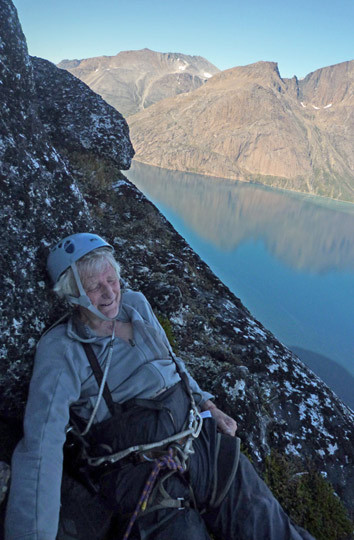
Shepton on an E2, 500m climb in Greenland. “I arrived at the top completely exhausted but it was a great experience,” he said. [Photo] xpedition.be
How did it feel being back on a rope after so long?
It was great, and they were really kind and helpful. We had a look at this route, which didn’t look too bad, but they admitted afterwards it was harder than they expected it to be. In British terms, it was about E2 and 500 meters. As I wrote in various articles, it was far too long and far too hard for an old man. But I enjoyed it. I arrived at the top completely exhausted, but it was a great experience.
Would you like to climb with the wild bunch again?
Yes, I’m hoping that we will. I’m now investigating the east side of Greenland, and trying to look for some big walls there–either there or Norway, but of course it’s more difficult to find unclimbed rock in Norway. I have heard of one or two places on the east side of Greenland that might have big climbs to be done. I’ve always avoided the east side in the sailing boats because you’ve got the arctic pack ice coming down on the East Greenland Current. Some years you can get in and some years you can’t. Whereas on the west side, you can always be assured to get in. The mountains aren’t quite as spectacular there though.
Were there any walls left behind that the team wanted to go back and try?
Yes, in the Upernavik area, which we’ve only just begun to explore. Hopefully these climbs that they’ve done will begin to open up this area. There’s certainly some big routes to be done. Actually, there’s another big route to be done just to the left of Devil’s Brew on Impossible Wall, which they put up. The Cape Farewell area in the south has been fairly well developed, but if you had time you could probably find more.
How did you pass the time while the climbers were on the wall?
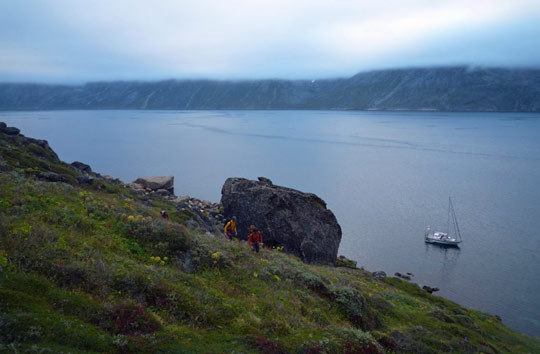
[Photo] xpedition.be
I went for two or three days to explore some other big walls further towards the ice cap. I wasn’t too successful though.
It was only the Impossible Wall that took ten or eleven days. The others were very long, one-day climbs–perhaps thirty hours or so. The Impossible Wall took so long because they were weather-bound for two or three days. I was around the corner, sheltered in a safer anchorage. I didn’t go out and look at them because I knew they would be suspended on the wall.
Other than that I would check on them every day. They had a hand-held radio and I had the ship radio, so we could communicate while they were on the wall.
When are you going back to Greenland?
I am due to go back this summer, meeting up with an Italian boat and then helping to crew that through the Northwest Passage, north of Canada and ending up in Alaska, I imagine.
What’s next? Would you consider doing trips like this in other parts of the world?
I’m limited by this criterion that there has to be big walls. There are plenty of places to go, and sort of climb. But to find big walls, you’re limited to Greenland and Norway. And I’ve recently heard of walls off the south coast of Newfoundland.
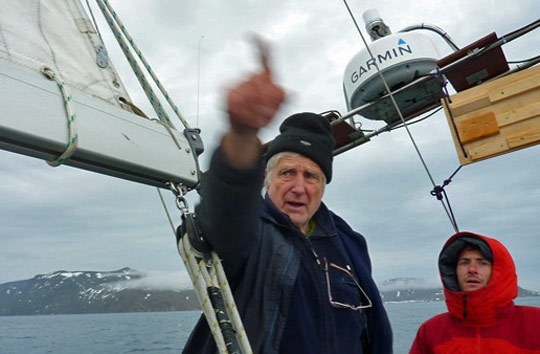
Bob Shepton [Photo] xpedition.be
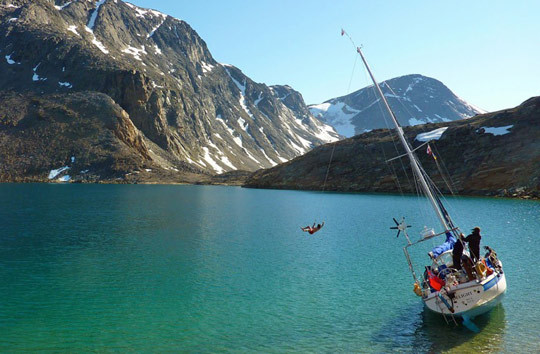
Sean Villanueva enjoys a sunny day in Greenland. [Photo] xpedition.be
Click here to read the first installment in Alpinist’s Nautical Series. Click here to read the second installment in Alpinist’s Nautical Series.